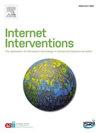混合跨诊断组CBT治疗情绪障碍的可行性、可接受性和初步疗效
IF 4.1
2区 医学
Q1 HEALTH CARE SCIENCES & SERVICES
Internet Interventions-The Application of Information Technology in Mental and Behavioural Health
Pub Date : 2025-03-28
DOI:10.1016/j.invent.2025.100823
引用次数: 0
摘要
跨诊断方法和基于互联网的管理可以帮助实施基于证据的治疗情绪障碍(ED)。然而,并不是所有的患者都能从在线模式中受益,而且辍学率很高。混合形式结合了面对面和互联网自我应用干预的优势,以帮助克服这些障碍。分组形式也有助于克服这些困难,提高成本效益。本研究旨在分析混合跨诊断组CBT治疗ed的可行性、可接受性及初步疗效。方法采用单组、开放试验设计,分为治疗前、治疗后和3个月随访三个测点。共34例成人,平均年龄32.21岁;来自至少有一项ED诊断符合DSM-5-TR标准的社区样本(79.4%女性)参加了研究。干预包括通过视频会议进行的8个小组会议,并在网络平台上完成16个在线模块。在所有参与者中,67.6%的人完成了治疗,另有14.7%的人完成了至少一半的模块并参加了至少一半的小组会议。患者对治疗的期望值和满意度较高(60分中分别为47.39分和49.39分)。系统的可用性在理想之上,在“优秀”左右(第一次使用平台后为84.02分,100分,后期处理为80.98分)。对在线模块和视频会议的评价很好。参与者平均完成了16个在线模块中的12.91个,平均参加了8个课程中的5.44个。与基线相比,治疗后和随访时焦虑和抑郁症状显著减少。其他二级临床指标也有显著变化。结论采用混合和分组形式的诊断方案治疗ED是可行的、可接受的、初步有效的,但还需要进一步的研究来验证这种创新形式的有效性。本文章由计算机程序翻译,如有差异,请以英文原文为准。
Feasibility, acceptability, and preliminary efficacy of a blended transdiagnostic group CBT for the treatment of emotional disorders
Introduction
The transdiagnostic approach and Internet-based administration can help to implement evidence-based treatments for emotional disorders (ED). However, not all patients benefit from online format and dropout rates are high. Blended format combines the strengths of face-to-face and Internet self-applied interventions to help overcome these barriers. Group format can also help to overcome these difficulties and improve the cost-effectiveness binomial. This study aimed to analyze the feasibility, acceptability, and preliminary efficacy of a blended transdiagnostic group CBT for ED.
Methods
A single-group, open-trial design with three measurement points: pre-treatment, post-treatment and 3-month follow-up. A total of 34 adults (mean age = 32.21 years; 79.4 % female) from a community sample with at least one ED diagnosis according to DSM-5-TR criteria participated in the study. The intervention combined 8 group sessions delivered via videoconference with the completion of 16 online modules in a web-platform.
Results
Of the total participants, 67.6 % completed the treatment and another 14.7 % completed at least half of the modules and attended at least half of the group sessions. The expectations and satisfaction with the treatment were high (47.39 and 49.39 out of 60, respectively). The system usability was above desirable and around ‘excellent’ (84.02 out of 100 after the first use of the platform and 80.98 out of 100 at post-treatment). Opinions on the online modules and videoconference sessions were good. Participants completed an average of 12.91 online modules out of 16 and attended an average of 5.44 sessions out of 8. There was a significant reduction in anxious and depressive symptomatology at post-treatment and follow-up compared to baseline. There was also a significant change in other secondary clinical measures.
Conclusions
A transdiagnostic protocol applied in blended and group formats seems to be feasible, acceptable and preliminary effective in addressing ED. However, more research is needed to test the efficacy of this innovative format.
求助全文
通过发布文献求助,成功后即可免费获取论文全文。
去求助
来源期刊

Internet Interventions-The Application of Information Technology in Mental and Behavioural Health
Medicine-Health Informatics
CiteScore
6.50
自引率
9.30%
发文量
94
审稿时长
6 weeks
期刊介绍:
Official Journal of the European Society for Research on Internet Interventions (ESRII) and the International Society for Research on Internet Interventions (ISRII).
The aim of Internet Interventions is to publish scientific, peer-reviewed, high-impact research on Internet interventions and related areas.
Internet Interventions welcomes papers on the following subjects:
• Intervention studies targeting the promotion of mental health and featuring the Internet and/or technologies using the Internet as an underlying technology, e.g. computers, smartphone devices, tablets, sensors
• Implementation and dissemination of Internet interventions
• Integration of Internet interventions into existing systems of care
• Descriptions of development and deployment infrastructures
• Internet intervention methodology and theory papers
• Internet-based epidemiology
• Descriptions of new Internet-based technologies and experiments with clinical applications
• Economics of internet interventions (cost-effectiveness)
• Health care policy and Internet interventions
• The role of culture in Internet intervention
• Internet psychometrics
• Ethical issues pertaining to Internet interventions and measurements
• Human-computer interaction and usability research with clinical implications
• Systematic reviews and meta-analysis on Internet interventions
 求助内容:
求助内容: 应助结果提醒方式:
应助结果提醒方式:


